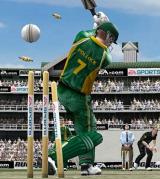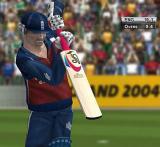The world of Flantiff and Vorner
Ben Wilson
|
|

|
Sadly, this isn't real life, as my batting has always been more Kevin the Teenager than Kevin Pietersen. This is a computer game named Brian Lara International Cricket 2005. It's a long way from Wicketz and Crickard. It's a long way too from Table Top Cricket, where you bowled on a synthetic mat with a metal ball, batted using a pulley system, and placed magnetic fielders to guard the boundary. It's even light years ahead of dot cricket - the most primitive form of computer cricket - which we played using the random number generator on a calculator.
But in those heady weeks of August 2005 when England's players were captivating the country, Lara was captivating the computer-games market. On August 23 it was top of the UK game charts, and its rival EA Cricket 2005 was at No. 5. Among the titles eclipsed by Lara were the spin-off from the hit cartoon Madagascar, not to mention Grand Theft Auto: San Andreas and Destroy All Humans!
For anyone raised on Owzthat dice, this might seem bewildering. But the games are great fun, and simpler than you might think. Push the CD into the PlayStation 2 (or its rival, the Xbox), connect it to your television, switch on, and begin. Such is the quality of current game technology that lifelike representations of Flintoff, Pollock and Tendulkar are at your immediate command. There is a seemingly endless array of matches and competitions, from ten-over slogs to five-match Test series.
What changed in 2005 was that two rival producers put out cricket titles at the same time, and the competition improved the products no end. Cricket had not been a big priority for software companies, with their eyes on the US market. But the Ashes season meant there were enough possibilities in cricketing countries to excite their interest.
Lara, made by Codemasters, first appeared in 1995 and, though it became a cult classic, there was a six-year hiatus after the 1999 version. In the meantime, EA Cricket, made by California-based Electronic Arts, moved into the gap. EA's attempt at cricket had only a fraction of the sophistication of its American football and basketball counterparts. (The commentary came from Richie Benaud and Jim Maxwell, sounding far more repetitive and jerky than they have ever been in real life.) That gap is now narrowing.
|
|

|
Combinations of buttons are used for shot selection or choosing the type of delivery. A fast bowler can produce a normal ball, inswinger, outswinger or slower ball though not, as yet, reverse swing.
The EA game holds a substantial advantage where licences are concerned: it offers a host of authentic international and club teams, with correct names and accurate likenesses. Its rival only has the licences for Lara himself and Ricky Ponting (whose name is used on the Australian version). Except in the World Cup, where different rules apply, all the other players have their names subtly changed to comply with legal requirements. This means that England have M. Vorner as captain and A. Flantiff as star allrounder.
EA Cricket has all the names, as well as Benaud, and is streets ahead in authenticity. When batting you need to play conservatively to build up confidence and are likely to get out by attempting risky shots early on. Defensive play is vital or you can collapse in a heap. The price of such accuracy is that it is not actually as much fun as the opposition. The Lara game is easier to learn and play, hence its popularity. Codemasters, a small company based in Leamington Spa with fewer than 400 employees - compared to EA's 6,000 - has thus been able to outsmart its opponent. It is a bit like Bangladesh beating Australia.
But at up to £40 a time, both are already being undercut by a free, web-based rival. Stick Cricket (www.stickcricket.com) relies on simple design and basic controls, yet has become a favourite time-waster in hundreds of offices.
The games designers, however, are looking to get ever more sophisticated. "We want the game to look more beautiful," says Sam Cordier of Codemasters. "We want to make the grass look like grass and get the breeze to move across it." It is not unreasonable to expect to have photo-realistic players under your control as 2007 comes around. That never happened with Owzthat dice.
Ben Wilson is games editor for Official UK PlayStation 2 Magazine.

